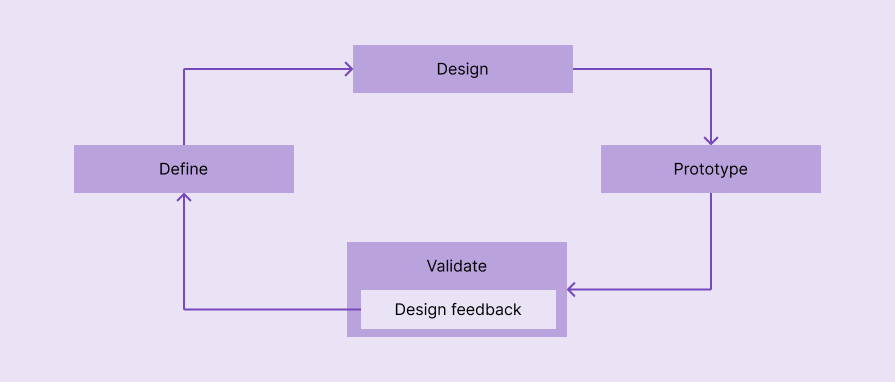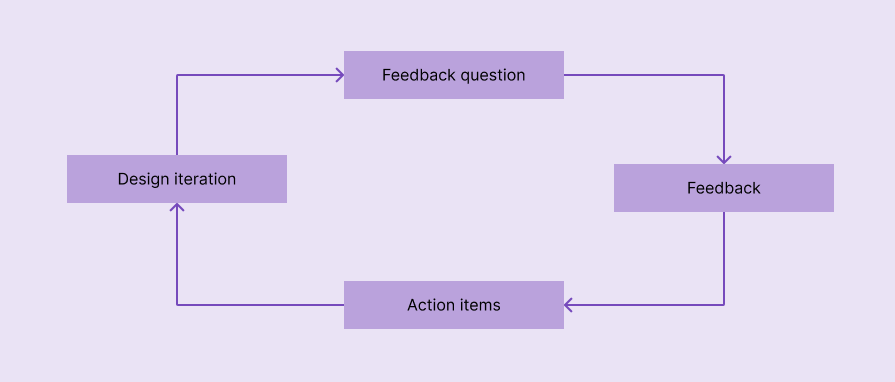7 design feedback questions to retire — and what to ask instead
In the UI/UX design process, work doesn’t end after one iteration. Designers continuously improve product designs until they meet the best version through multiple feedback-driven cycles. Each design iteration ends with a stakeholder demo and begins again based on the feedback received.
That means the quality of questions asked during design feedback sessions directly impacts how helpful and actionable the feedback is. Asking better questions ensures the design evolves in the right direction. Yet many design sessions still begin with vague prompts like, “What do you think?” — a question that usually yields generic, unhelpful responses.
In this guide, you’ll learn what makes a good design feedback question, which types to avoid, and what to ask for conducting an effective, productive design feedback session.
Why are design feedback questions important?
A design feedback session connects the end of an iteration of the UI/UX design process with the start of a new design iteration:

Questions that designers ask during a design feedback session affect the entire feedback-gathering process. Well-planned, helpful questions help designers maximize the session’s benefits by driving the feedback session effectively to start a new design iteration with new requirements productively:

In a design feedback session, good feedback questions will:
- Initiate the design feedback session smoothly — A design demo is usually a presentation conducted by designers to stakeholders, and designers usually activate stakeholders’ voices by asking initial design feedback questions
- Set the feedback context — Broad design feedback won’t be very helpful in UI/UX design iterations, so designers can ask contextful questions to gather the right, specific feedback from stakeholders, saving everyone’s time
- Directing the feedback session flow — Feedback gathering and defining design requirements based on feedback become easier if the feedback session has a well-organized flow. Well-planned feedback questions will effectively direct the feedback session flow
Characteristics of a good feedback question
A good feedback question with the following characteristics will smoothly initiate the design feedback session and drive it effectively:
- Clarity — Stakeholders in your design demo audience have different experience levels, domain knowledge, and technical skills. Designers should ask clear, simple feedback questions that every person in the audience can easily understand
- Conciseness — Asking long feedback questions isn’t effective, but we can’t ask short questions that typically end with yes/no or too broad answers. Designers should ask simple but expressive questions to gather valuable feedback
- Contextful — Questions that automatically narrow down the possible answers’ scope will help stakeholders provide clear, effective answers without asking another question to know the question’s scope or context
- Flexible — Stakeholders shouldn’t be forced to give a specific, pre-defined answer, but broad, open-minded questions aren’t very helpful for the design process. So, asking flexible, contextful, open-minded, or multiple-choice questions is a great decision
- Valuable — Double-thinking an imagined question’s value addition to the design process will help designers effectively and ethically consume the allocated design meeting time
Feedback questions to avoid and what to ask instead
Let’s learn how to prepare better, helpful feedback questions based on the above characteristics by identifying common questions that we should avoid.
1. Avoid vague, broad questions — ask specific, contextful ones instead
In most scenarios, answers to vague, broad feedback questions don’t bring enough identifiable points to consider during the next design iteration. Broad questions can confuse the audience while preparing an answer, and often bring neutral or vague answers.
Always try to be specific to help the audience prepare concise, targeted answers that help deliver good results in the next design iteration.
Examples:
- Instead of “What do you think about the app?” ask “What features did you find most useful for your frequent tasks?”
- Instead of “How was the user registration?” ask “How easy was it to register on the new app?”
- Instead of “What’s your feedback for the new content arrangement?” ask “In the new design, which contents did you find most important, and which aren’t important for you?”
2. Avoid too-specific questions — ask flexible ones instead
Asking too-specific questions can consume more time for stakeholders while they prepare answers because being overly specific adds unwanted requirements and restrictions to the expected answer. Asking flexible but specific questions by avoiding technical details, exact user flow mentions, and exact past behaviors motivates everyone to provide feedback.
Examples:
- Instead of “What’s the font size you think is most suitable for this heading?” ask “How would you like to increase this heading size to look better?”
- Instead of “Do you think the new design’s color palette is too dark or bright?” ask “What are your thoughts on the new color selections? Do you find they are visually appealing or not?”
- Instead of “While following the user-flow #12 and selecting a location using the three-letter location code under the user flow #20, how easy was it to find your preferred location?” ask “How easy was it to find a location while entering three-letter location codes during shipment creation?”
3. Avoid leading questions — ask open-ended but specific ones instead
A negative feedback point is more helpful than a positive one from stakeholder feedback, since a negative feedback point usually represents a valid UX pain point that we should eliminate for better usability. Asking biased questions on the positive side can hide improvement points that we should look at.
Ask open-ended but specific questions instead of leading questions to ask for feedback neutrally to gather both positive and negative feedback points.
Examples:
- Instead of “Didn’t you notice the productivity enhancements of the new version?” ask “What are the new features that improved your productivity in the new version?”
- Instead of “The advanced search feature satisfies all your requirements, right?” ask “Please share if the advanced search feature is helpful for your work or not?”
- Instead of “Is the product creation screen frustrating and less productive?” ask “What would you like to change in the product creation screen?”
4. Avoid binary questions — ask for rating scales, multiple-choice, or specific answers instead
In some scenarios, yes/no questions are helpful to ask the user’s quick opinions regarding specific details (e.g., in in-app feedback about new features), but asking broad, yes/no questions doesn’t let stakeholders express their insights about UX freely.
Asking rating scales, multiple choice, or specific answers instead of binary questions is a great way to be specific and flexible for answers without being too broad.
Examples:
- Instead of “Do you think the overall app is beautiful?” ask “How would you rate the overall visual design on a 0 to 10 scale?”
- Instead of “Do you like the welcome screen?” ask “What did you like or dislike in the welcome screen?”
- Instead of “Is the overall UX good or bad?” ask “How would you rate overall UX: very poor, poor, neutral, good, very good?”
5. Avoid combining questions — ask distinct ones instead
Combined questions often become complex and increase ambiguity, so stakeholders can be confused if designers ask combined questions. In most scenarios, when a complex combined question is asked, stakeholders will properly answer only one question and forget the other question, or they will provide a vague answer due to confusion.
Asking distinct questions eliminates ambiguity and makes everything clear.
Examples:
- Instead of “How easy was it to select a travel destination and what did you like or dislike in the summary screen?” ask “How easy was it to select a travel destination?” first, and then “What did you like or dislike in the travel destination summary screen?”
- Instead of “What are your thoughts on color selections and the content arrangement?” ask “What are your thoughts on color selections?” first, and then “What did you like or dislike about the content arrangement?”
- Instead of “What difficulties did you face while uploading files, and how easy was it to find the remaining storage quota?” ask “What difficulties did you face while uploading files?” first, and then “How easy was it to find the remaining storage quota?”
6. Avoid complex, technical, unclear language — ask simple questions
A demo day is when different people meet together to evaluate a product design. Complex, technical, and unclear language can create communication barriers between demo day participants and designers and make the overall feedback-gathering session less productive. So, forming simple, clear questions by avoiding complex, technical language is mandatory during any feedback session or general design critique.
Examples:
- Instead of “Do you think the new drawer menu design adheres to UI/UX design standards and satisfies mandatory usability requirements?” ask “How easy was it to use the new main menu?”
- Instead of “Do you think we should introduce a CTA button using the primary accent color?” ask “What are your thoughts on using a button?”
- Instead of “Did you notice you’ve experienced cognitive overload while perceiving the initial application state?” ask “What are your thoughts on the complexity of the initial screen?”
7. Avoid asking about abilities or feelings — ask about the experience instead
A good product treats every user the same, regardless of their abilities, with accessibility principles, so designers shouldn’t reveal stakeholders’ abilities and special user requirements during a feedback session. On the other hand, asking about personal feelings is not ethical and also not useful as a common design enhancement point.
So, designers should focus on asking about the experience without directly asking about abilities or feelings, it’s up to feedback session participants to share emotions or abilities they experienced while using the product.
- Instead of “Weren’t you able to complete the payment step faster in this improved design?” ask “Did you find the new design’s payment step productive?”
- Instead of “What did you feel about the new header image?” ask “What are your thoughts on selecting this as the header image?”
- Instead of “What do you feel about the product’s overall UX?” ask “How do you describe the overall experience with the product?”
How to turn a bad question into a good one?
You don’t need to re-create the entire feedback question set if you notice that the prepared questions don’t have the characteristics of a good feedback question. You can undoubtedly review the question set, identify bad ones, and turn them into good ones by following these steps:
- Read each question and try to form a concise answer as a user. Identify questions that are harder to understand and don’t practically produce a concise answer
- Take each problematic question and validate with good feedback question characteristics: clarity, conciseness, contextful, flexibility, and value
- Rephrase the bad question based on the good feedback question characteristics and the above 7 types of question examples
- Validate the rephrased question by reading it again as a user and checking against good feedback question characteristics and the 7 types of questions that we should avoid

Example: “What do you think about the new app version?”
- The question is harder to answer because it doesn’t set a scope for the expected answer
- The question is simple and flexible (open-minded), but it’s not contextful, and its answer doesn’t add value to the next design iteration since it will probably become too broad
- As described in question type 1, we can add more value to it by adding a scope/context for the expected answer: “What features did you find most useful in the new version?”
- The rephrased question sets context and scope by mentioning “useful features” but also accepts the most negative answer: “None of the new features are useful.”
Conclusion
In this article, we studied the importance of asking better feedback questions, characteristics of a good feedback question, and what questions we should avoid, and what to ask instead. Feedback questions are so important in design feedback sessions since they initiate the feedback-gathering process and drive it with a better flow that helps designers identify design requirements in a proper order.
Planning feedback questions based on good feedback question characteristics and avoiding the 7 types of questions we’ve discussed in this article will make your design feedback session more productive and useful than imagining feedback questions at the last minute.
The post 7 design feedback questions to retire — and what to ask instead appeared first on LogRocket Blog.
This post first appeared on Read More


